The Indigenous Dogon People
Ethnonyms: Dogom, Habe Countries inhabited: Mali Language family: Niger-Congo Language branch: Dogon
Click/tap an image to begin a captioned slideshow and, where available, stock licensing information.
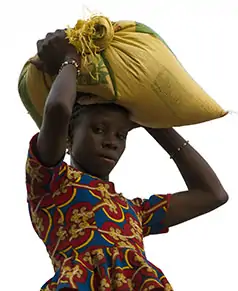
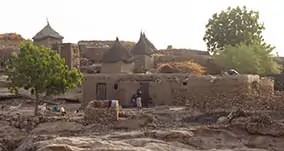 Begnimatu is, on most days of the year, a very typical village inhabited by the indigenous Dogon people of Mali, West Africa. Sitting atop the Bandiagara Escarpment, it overlooks "Dogon Country" for as far as the eye can see — even on a clear day. In the lowlands the earth is quite barren, but up here it is even more barren. Herding is the main village livelihood, goats and sheep, but there is also some agriculture. Every five days women and girls ascend the few hundred meters back up to Begnimatu in the evening after descending in the morning down to the village of Doundiourou where they trade their produce in that village's market.
Begnimatu is, on most days of the year, a very typical village inhabited by the indigenous Dogon people of Mali, West Africa. Sitting atop the Bandiagara Escarpment, it overlooks "Dogon Country" for as far as the eye can see — even on a clear day. In the lowlands the earth is quite barren, but up here it is even more barren. Herding is the main village livelihood, goats and sheep, but there is also some agriculture. Every five days women and girls ascend the few hundred meters back up to Begnimatu in the evening after descending in the morning down to the village of Doundiourou where they trade their produce in that village's market.
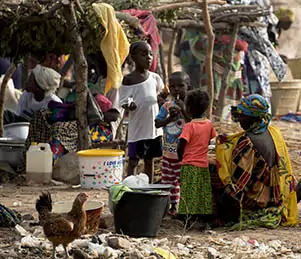 Such micro-economic commerce is the lifeblood of survival throughout Dogon Country; indeed it has been since the Dogon people first arrived here some 600 years ago. Begnimatu is a natural starting (or ending) point for a visit to the area and to the Dogon people. The population is just a few hundred people who practice Christianity,
Such micro-economic commerce is the lifeblood of survival throughout Dogon Country; indeed it has been since the Dogon people first arrived here some 600 years ago. Begnimatu is a natural starting (or ending) point for a visit to the area and to the Dogon people. The population is just a few hundred people who practice Christianity,
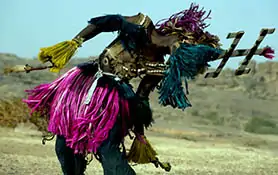 Islam and the original Dogon religion, Animism.
Islam and the original Dogon religion, Animism.
It is on only a few days of the year that the visitor might witness the religious and cultural heritage of Animism in the form of
tribal masked dancing.
The Dama is a Dogon funeral ritual based on ancient beliefs. Seldom performed in earnest these days — and even then closed to outsiders — the visitor can pay to observe a re-enactment. The dancing became codified differently in various Dogon villages —
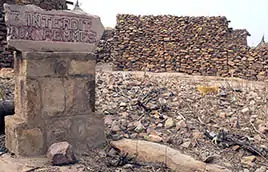 as did the precise design of the masks. But one aspect is consistent: only males perform the rites.
as did the precise design of the masks. But one aspect is consistent: only males perform the rites.
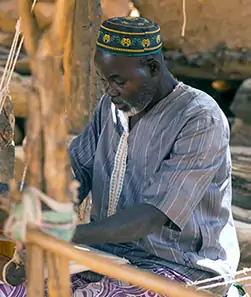 Dogon masked dancing is only one example of the strict observance of gender roles and expectations in their villages. In Ogosogu the ruins of the first house ever built are left to lie as a reminder of the village's past. A sign (in French, the Dogon language has no writing system) reads: "Interdit aux Femmes" and translates to "Women not Allowed." Its purpose is to instruct female inhabitants not to walk over these ruins. The rationale is that women may be unclean and,
Dogon masked dancing is only one example of the strict observance of gender roles and expectations in their villages. In Ogosogu the ruins of the first house ever built are left to lie as a reminder of the village's past. A sign (in French, the Dogon language has no writing system) reads: "Interdit aux Femmes" and translates to "Women not Allowed." Its purpose is to instruct female inhabitants not to walk over these ruins. The rationale is that women may be unclean and,
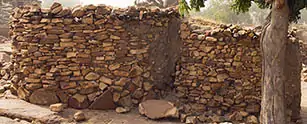 if so, will disturb the souls of the ancestral inhabitants who now live in the afterlife.
if so, will disturb the souls of the ancestral inhabitants who now live in the afterlife.
Back in Begnimatu, this Dogon man happily spends his days weaving cloth.
The gender appropriateness of his chosen vocation is as unquestioned as his cleanliness. Yet Dogon villages where Animism is still practiced have a dedicated menstrual house (or hut, yapunu gina) to which menstruating women and pubescent girls are banished.
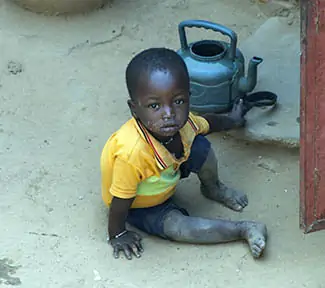 The given explanation is that they are unclean during these days.
The given explanation is that they are unclean during these days.
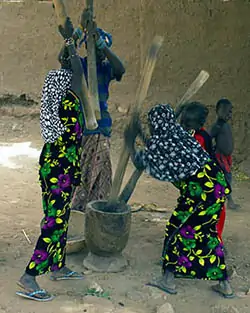 The more likely reason is that this practice developed to prevent cuckoldry. (Pubescent girls still sometimes marry
in their early teens in Dogon society,
but marriage is not considered consummated until the firstborn can be heard crying.) Scientific field study suggests it is an effective practice.
The more likely reason is that this practice developed to prevent cuckoldry. (Pubescent girls still sometimes marry
in their early teens in Dogon society,
but marriage is not considered consummated until the firstborn can be heard crying.) Scientific field study suggests it is an effective practice.
When they are not isolated inside menstrual houses, Dogon women and girls can be seen performing many of their village's daily tasks. During harvest time those tasks include pounding millet — one of the staple crops of the area. Outside of harvest season, women, and older girls who are not yet married, no longer attend school or have never attended school, are mostly preoccupied with cooking, cleaning and caring for the very young.
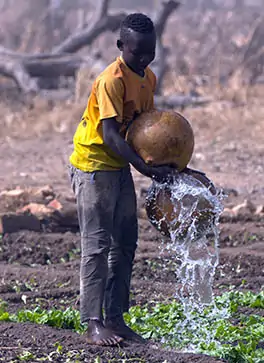 Dogon society traditionally elevates women both symbolically and practically because of their fertility and, therefore, their ability to procreate. It is no coincidence that these assigned duties reflect the female role in future survival.
Dogon society traditionally elevates women both symbolically and practically because of their fertility and, therefore, their ability to procreate. It is no coincidence that these assigned duties reflect the female role in future survival.
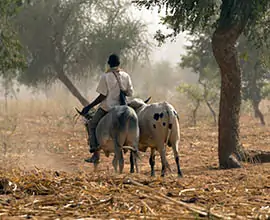 Providing for their family (which may include many children and more than one wife) is the domain of men.
It is they who tend the fields in which subsistence crops (millet, sorghum, groundnuts and cassava) are grown. It is also they who work the labor-intensive cultivation of cash crops such as onion and tobacco on smaller plots that are best called gardens.
Providing for their family (which may include many children and more than one wife) is the domain of men.
It is they who tend the fields in which subsistence crops (millet, sorghum, groundnuts and cassava) are grown. It is also they who work the labor-intensive cultivation of cash crops such as onion and tobacco on smaller plots that are best called gardens.
While millet and sorghum do not require manual irrigation, the land must be plowed and planted — which are also labor-intensive tasks. No mechanization is practiced due to the low economic standard of living, so oxen are the ubiquitous beasts of burden. As in all parts of Africa, drought can impact Dogon Country. An already-harsh life is severely impacted when crops fail due to drought.
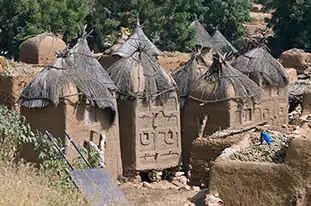 When the crops are successful they are stored after the harvest season in granaries. Here again, there is a traditional gender discrimination at play. The larger ones are considered "male" granaries (guy ana). Smaller granaries are "female" (guyo ya). They are used to store women's personal belongings. Women do not enter male granaries and nor do men enter female ones.
When the crops are successful they are stored after the harvest season in granaries. Here again, there is a traditional gender discrimination at play. The larger ones are considered "male" granaries (guy ana). Smaller granaries are "female" (guyo ya). They are used to store women's personal belongings. Women do not enter male granaries and nor do men enter female ones.
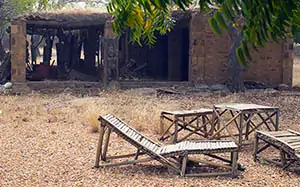 Dogon country has long been one of the most popular destinations in West Africa for tourists and travelers. But since 2012 Mali has suffered significant political unrest and often extreme violence. Many governments now advise their citizens against all travel to Mali.
Dogon country has long been one of the most popular destinations in West Africa for tourists and travelers. But since 2012 Mali has suffered significant political unrest and often extreme violence. Many governments now advise their citizens against all travel to Mali.
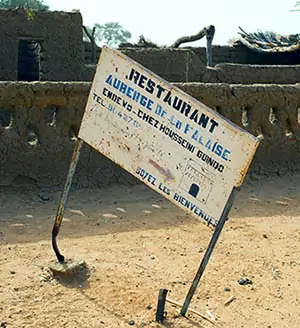 As a result, the number of visitors who pass through has dwindled down to the odd few. Guesthouses and restaurants that once flourished are now in a dilapidated state of disrepair as their upkeep has become uneconomical.
As a result, the number of visitors who pass through has dwindled down to the odd few. Guesthouses and restaurants that once flourished are now in a dilapidated state of disrepair as their upkeep has become uneconomical.
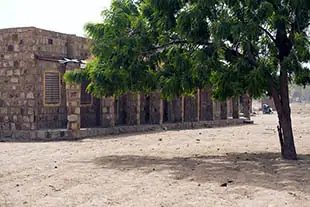 Dogon communities that once supplemented their livelihood from tourism
have suffered and many families have had to find replacement sources of income. For most, this has involved labor migration of young men to cities such as Bandiagara, Mopti and even Bamako, where they find low-paying, temporary wage-labor jobs. Few Dogon have the skills or the education necessary to pursue a well-paid occupation. Such migration, of course, brings about loss of culture.
Dogon communities that once supplemented their livelihood from tourism
have suffered and many families have had to find replacement sources of income. For most, this has involved labor migration of young men to cities such as Bandiagara, Mopti and even Bamako, where they find low-paying, temporary wage-labor jobs. Few Dogon have the skills or the education necessary to pursue a well-paid occupation. Such migration, of course, brings about loss of culture.
But things are changing. Often these days the best buildings in Dogon villages —
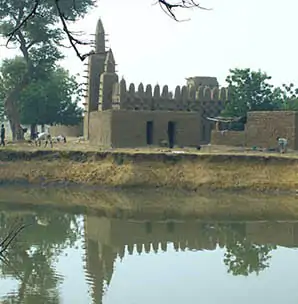 alongside mosques — are schools. These schools are very basic and their funding comes
alongside mosques — are schools. These schools are very basic and their funding comes
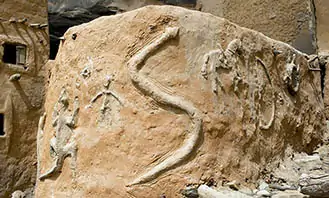 mainly from foreign aid agencies. When the Dogon first arrived here they lived in dwellings carved into the high escarpment. They could not have imagined that a few hundred years later there would be permanent settlements in the valley where children would learn about things they didn't know in places called schools. They likely did imagine, however, that future generations would continue their cultural heritage. And they were correct.
mainly from foreign aid agencies. When the Dogon first arrived here they lived in dwellings carved into the high escarpment. They could not have imagined that a few hundred years later there would be permanent settlements in the valley where children would learn about things they didn't know in places called schools. They likely did imagine, however, that future generations would continue their cultural heritage. And they were correct.
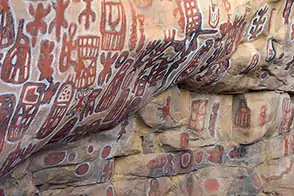 Ancient Dogon belief is still a subject of anthropological research.
The key question debated centers around their purported ancient, detailed knowledge of the star system, Sirius. The three leading theories posit that
Ancient Dogon belief is still a subject of anthropological research.
The key question debated centers around their purported ancient, detailed knowledge of the star system, Sirius. The three leading theories posit that
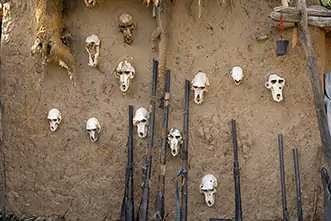 (a) their ancient ancestors were visited by extraterrestrials; (b) they gained and later assimilated astronomical knowledge from their
earliest contact with scientists who visited their communities in the 19th Century; and (c) the anthropologists who first reported their knowledge of Sirius were unwittingly misled by their field research techniques.
(a) their ancient ancestors were visited by extraterrestrials; (b) they gained and later assimilated astronomical knowledge from their
earliest contact with scientists who visited their communities in the 19th Century; and (c) the anthropologists who first reported their knowledge of Sirius were unwittingly misled by their field research techniques.
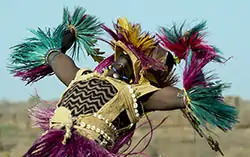 Whatever the reality, there is no question that the Dogon continue to practice traditions that date back thousands of years.
Circumcision of young boys is a ceremonial event that always takes place in a dedicated, secluded place. Huntsmen preserve the skulls of their prey to honor their spirit and bring fortune to future hunts. And masked dancers will continue to perform their rituals for many generations to come.
Whatever the reality, there is no question that the Dogon continue to practice traditions that date back thousands of years.
Circumcision of young boys is a ceremonial event that always takes place in a dedicated, secluded place. Huntsmen preserve the skulls of their prey to honor their spirit and bring fortune to future hunts. And masked dancers will continue to perform their rituals for many generations to come.
Photography and videography copyright © 1999 -
2025,
Ray Waddington. All rights reserved.
Text copyright © 1999 -
2025,
The Peoples of the World Foundation. All rights reserved.

Waddington, R. (2018), The Indigenous Dogon People. The Peoples of the World Foundation. Retrieved December 17, 2025, from The Peoples of the World Foundation. <https://www.peoplesoftheworld.org/text?people=Dogon>
Web Links
Indigenous Dances of West Africa (short film on YouTube)
Living and Spirtual Worlds of Mali's Dogon People
Dogon and Bangime Linguistics
Investigating the Relatedness of the Endangered Dogon Languages
Books
Pern, S., (1982) Masked Dancers of West Africa: The Dogon. Amsterdam: Time-Life Books B.V.
Scranton, L., (2007) Sacred Symbols of the Dogon: The Key to Advanced Science in the Ancient Egyptian Hieroglyphs. Rochester, VT: Inner Traditions.
van Beek, W.E.A., (2001) Dogon: Africa's People of the Cliffs. New York, NY: Harry N. Abrams, Inc.

